Hitler's Life Timeline
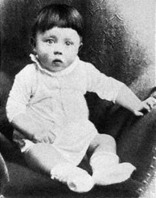
Hitler as a baby ('Google')
1889 April
Adolf Hitler is born on April 20th in Braunau am Inn on the empire of Austria-Hungary and the German Reich. Both of peasant backgrounds, his father, Alois Hitler was a strict man. Hitler’s mother, Klara was nurturing and kind, but eventually fell into depression ("Hitler Timeline").
1895
Adolf begins school at the Realschule ("Hitler, Adolf," pg. 19) at age six. He demonstrates high intelligence, but is uninterested in formal schooling resulting in a poor educational record ("Hitler Timeline").
1907
Hitler, with the clear intention of becoming an artist, moves to Vienna to attend the Academy of Art. When his application was rejected, he described it as a "bolt from the blue," ("Hitler, Adolf," pg. 20). He then moved on to apply at the School of Architecture, but is again disappointed due to his inability to provide a high school diploma ("Hitler Timeline").
Adolf Hitler is born on April 20th in Braunau am Inn on the empire of Austria-Hungary and the German Reich. Both of peasant backgrounds, his father, Alois Hitler was a strict man. Hitler’s mother, Klara was nurturing and kind, but eventually fell into depression ("Hitler Timeline").
1895
Adolf begins school at the Realschule ("Hitler, Adolf," pg. 19) at age six. He demonstrates high intelligence, but is uninterested in formal schooling resulting in a poor educational record ("Hitler Timeline").
1907
Hitler, with the clear intention of becoming an artist, moves to Vienna to attend the Academy of Art. When his application was rejected, he described it as a "bolt from the blue," ("Hitler, Adolf," pg. 20). He then moved on to apply at the School of Architecture, but is again disappointed due to his inability to provide a high school diploma ("Hitler Timeline").

Painting by Hitler ('Hitler Painting')
1909-1913
Hitler lived in poverty during this time. He lived in an all-male hostel and sold post cards drawn by his own hand. He also took on various small jobs to make a living ("Hitler Timeline").
During this time of hardship, Hitler also often took part in political activity. He attended meetings and made sure to be informed by reading political newspapers and other literature of sorts ("Hitler Timeline").
1913
Hitler is faced with draft requirements from the Hapsburg Empire. He tries to avoid this by fleeing to Munich in Southern Germany ("Hitler Timeline").
Hitler lived in poverty during this time. He lived in an all-male hostel and sold post cards drawn by his own hand. He also took on various small jobs to make a living ("Hitler Timeline").
During this time of hardship, Hitler also often took part in political activity. He attended meetings and made sure to be informed by reading political newspapers and other literature of sorts ("Hitler Timeline").
1913
Hitler is faced with draft requirements from the Hapsburg Empire. He tries to avoid this by fleeing to Munich in Southern Germany ("Hitler Timeline").
1914
Hitler volunteers for the German Army during World War One and joins the 16th Barvarian Reserve Infantry Regiment. He was eventually promoted to corporal, and was also rewarded the Iron Cross for his service as a runner on the western front ("Hitler Timeline").
1918
Hitler endures temporary blindness as a result from a British gas attack in Ypres Salient, but soon returns to his duties ("Hitler Timeline").
Hitler volunteers for the German Army during World War One and joins the 16th Barvarian Reserve Infantry Regiment. He was eventually promoted to corporal, and was also rewarded the Iron Cross for his service as a runner on the western front ("Hitler Timeline").
1918
Hitler endures temporary blindness as a result from a British gas attack in Ypres Salient, but soon returns to his duties ("Hitler Timeline").
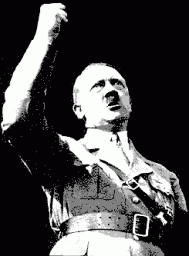
('Hitler Speaking')
1919
Hitler decides to remain in the army where he is appointed to the Intelligence and Propaganda section. Here, he strongly promotes nationalism and anti-Socialism for Germany. He also took on the task of acting as an informer, otherwise known as a spy. Adolf also joined the German Worker’s Party where he took care of publicity and propaganda ("Hitler Timeline").
1920
Hitler is discharged from the army, but while still a member of the German Worker's Party he changed the name to the National Socialist German Worker's Party (also known as the Nazi Political Party), which expressed extreme hatred for politician who signed the Treaty of Versailles. He was the leader of this organization until Anton Drexler agreed to take his place in 1921 ("Hitler Timeline").
Hitler decides to remain in the army where he is appointed to the Intelligence and Propaganda section. Here, he strongly promotes nationalism and anti-Socialism for Germany. He also took on the task of acting as an informer, otherwise known as a spy. Adolf also joined the German Worker’s Party where he took care of publicity and propaganda ("Hitler Timeline").
1920
Hitler is discharged from the army, but while still a member of the German Worker's Party he changed the name to the National Socialist German Worker's Party (also known as the Nazi Political Party), which expressed extreme hatred for politician who signed the Treaty of Versailles. He was the leader of this organization until Anton Drexler agreed to take his place in 1921 ("Hitler Timeline").
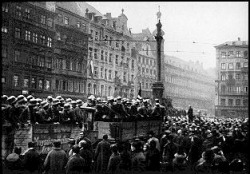
November 1923 ('BeerHall Putsch')
1923
As new president of the Nazi Party, he and General Ludenorff attempted to overthrow the Bavarian Government. Hitler, along with 2000 Nazi's marched through Munich to take over the meeting of three important Bavarian Politicians.
The following day, police open fire while Nazi's march in the streets. Hitler attempted to escape, but was caught and tried with treason to serve 9 months in prison. During this time, he began dictating his thoughts to Rudolf Hess resulting in the book Mein Kampf, meaning "My Struggle or My Journey."
Today, this event is known as The Beer Hall Putsch ("Hitler Timeline").
As new president of the Nazi Party, he and General Ludenorff attempted to overthrow the Bavarian Government. Hitler, along with 2000 Nazi's marched through Munich to take over the meeting of three important Bavarian Politicians.
The following day, police open fire while Nazi's march in the streets. Hitler attempted to escape, but was caught and tried with treason to serve 9 months in prison. During this time, he began dictating his thoughts to Rudolf Hess resulting in the book Mein Kampf, meaning "My Struggle or My Journey."
Today, this event is known as The Beer Hall Putsch ("Hitler Timeline").
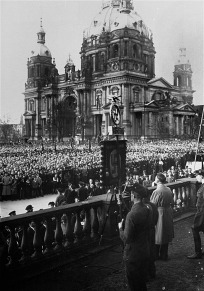
Hitler speaks at Berlin Lustgarten ('USHMM')
1925
Hitler rises the Nazi Party once more ("Hitler Timeline").
1930
The Nazi party increases Parliamental Representatives from 14 to 107, making Hitler the leader of the second largest party in Germany ("Hitler Timeline").
1932
Hitler becomes an official German citizen (due to the fact that he was born on Austrian borders) allowing him to run against Paul von Hindenburg in a Presidential Election once more as he did the year before ("Hitler Timeline").
Hitler rises the Nazi Party once more ("Hitler Timeline").
1930
The Nazi party increases Parliamental Representatives from 14 to 107, making Hitler the leader of the second largest party in Germany ("Hitler Timeline").
1932
Hitler becomes an official German citizen (due to the fact that he was born on Austrian borders) allowing him to run against Paul von Hindenburg in a Presidential Election once more as he did the year before ("Hitler Timeline").
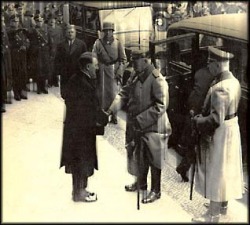
Hitler at his Inaugeration ('Google')
1933-January
On January 30, 1933, Hitler is elected chancellor ("Hitler Timeline").
1933-March
Gesetz zur Behebung der Not von Volk und Reich, translated as "Law to Remedy the Distress of the People and the Nation," and formally known as The Enabling Act was passed in 1933. It was signed by President Paul von Hindenburg ("Enabling Act"). This act gave all powers from legislation to Hitler's Cabinet, making his government a legal dictatorship.
Hitler proclaims the Nazi Party the only legal party in Germany, eliminating all other parties. Any individual states in Germany lost all powers making Nazi officials State Governers ("Hitler Timeline")
On January 30, 1933, Hitler is elected chancellor ("Hitler Timeline").
1933-March
Gesetz zur Behebung der Not von Volk und Reich, translated as "Law to Remedy the Distress of the People and the Nation," and formally known as The Enabling Act was passed in 1933. It was signed by President Paul von Hindenburg ("Enabling Act"). This act gave all powers from legislation to Hitler's Cabinet, making his government a legal dictatorship.
Hitler proclaims the Nazi Party the only legal party in Germany, eliminating all other parties. Any individual states in Germany lost all powers making Nazi officials State Governers ("Hitler Timeline")
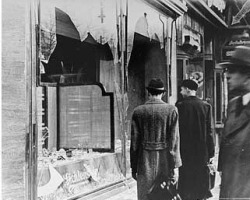
Krystallnacht or Night of Glass ('OConnor')
1933-October
Hitler triples the size of Germany, ignoring the Treaty of Versailles ("Hitler Timeline").
1934
The death of President Hindenburg allows Hitler to become Fuhrer and Reich Chancellor of Germany. During this time he bands the name 'President' and any opposition within the Nazi Party ("Hitler Timeline").
1938
The Austrian Chancellor invites Germany to occupy Austria as a proclamation of unity between the two. In the same year, Britain, Italy, and France sign the Munich Agreement, giving Sudetenland to Germany.
On November 9th and 10th, the night known as Kristallnacht (directly translated as Crystal Night or Night of Glass) occurs ("Kristallnacht"). 7,500 Jewish Shops are destroyed and 400 Jewish synagogues are burnt as a reaction to the death of a German Politician by the hand of a Jewish refugee ("Hitler Timeline").
Hitler triples the size of Germany, ignoring the Treaty of Versailles ("Hitler Timeline").
1934
The death of President Hindenburg allows Hitler to become Fuhrer and Reich Chancellor of Germany. During this time he bands the name 'President' and any opposition within the Nazi Party ("Hitler Timeline").
1938
The Austrian Chancellor invites Germany to occupy Austria as a proclamation of unity between the two. In the same year, Britain, Italy, and France sign the Munich Agreement, giving Sudetenland to Germany.
On November 9th and 10th, the night known as Kristallnacht (directly translated as Crystal Night or Night of Glass) occurs ("Kristallnacht"). 7,500 Jewish Shops are destroyed and 400 Jewish synagogues are burnt as a reaction to the death of a German Politician by the hand of a Jewish refugee ("Hitler Timeline").
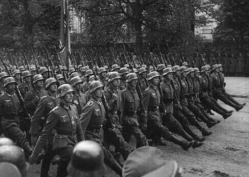
('Blitzkrieg')
1939
The Molotov-Ribbentrop Pact, also known as the Treaty of Non-Aggression between the Third Reich and the Union of Soviet Socialist Republics (which involved Russia) was signed on August 24 ("Molotov–Ribbentrop Pact."). Almost right afterward, Hitler invaded Poland causing the country to be divided between Germany and Russia ("Hitler Timeline").
1940
The Nazis occupy Denmark, Norway, Holland, Belgium, France, while Romania, and Yugoslavia is invaded ("Hitler Timeline").
The Molotov-Ribbentrop Pact, also known as the Treaty of Non-Aggression between the Third Reich and the Union of Soviet Socialist Republics (which involved Russia) was signed on August 24 ("Molotov–Ribbentrop Pact."). Almost right afterward, Hitler invaded Poland causing the country to be divided between Germany and Russia ("Hitler Timeline").
1940
The Nazis occupy Denmark, Norway, Holland, Belgium, France, while Romania, and Yugoslavia is invaded ("Hitler Timeline").
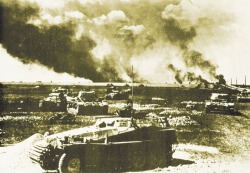
('Operation Barbarossa')
1941
The German invasion of Russia begins known as Operation Barbossa. Later that same year, Japan (an ally of Germany) attacks Pearl Harbour and war is declared on the U.S. ("Hitler Timeline").
1943
The Germans surrender, against Hitler's orders at the Battle of Stalingrad. Germany continues to retreat after this event ("Hitler Timeline").
The German invasion of Russia begins known as Operation Barbossa. Later that same year, Japan (an ally of Germany) attacks Pearl Harbour and war is declared on the U.S. ("Hitler Timeline").
1943
The Germans surrender, against Hitler's orders at the Battle of Stalingrad. Germany continues to retreat after this event ("Hitler Timeline").
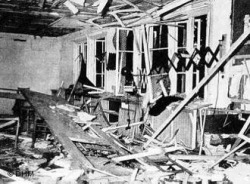
('Hitler Asassination Attempt')
1944
An attempt to kill Hitler was made by Colonel Stauffenberg. The attempt failed causing Hitler to react by killing any possible suspects ("Hitler Timeline").
1945
Despite the Soviet Troops occupation in Germany, Hitler decides to stay in Berlin ("Hitler Timeline").
An attempt to kill Hitler was made by Colonel Stauffenberg. The attempt failed causing Hitler to react by killing any possible suspects ("Hitler Timeline").
1945
Despite the Soviet Troops occupation in Germany, Hitler decides to stay in Berlin ("Hitler Timeline").
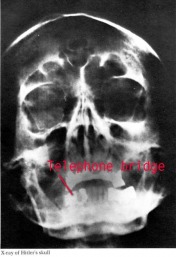
('Google')
April 30, 1945
It is said that Hitler committed suicide with his wife Eva Braun on this day ("Hitler Timeline"). However, the debate still continues due to the discovery of supposed remaining pieces of Hitler's skull found in Moscow ("Rosenbaum," pg. 1) and suspicions of fraud which have accumulated over the years ("Berlin Fake").
This debate will be researched further and this website will be updated later on.
It is said that Hitler committed suicide with his wife Eva Braun on this day ("Hitler Timeline"). However, the debate still continues due to the discovery of supposed remaining pieces of Hitler's skull found in Moscow ("Rosenbaum," pg. 1) and suspicions of fraud which have accumulated over the years ("Berlin Fake").
This debate will be researched further and this website will be updated later on.
